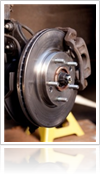We are often concerned with brake pad wear and overlook the condition of brake fluid. Brake fluid is a vital component of our brake system. It is responsible for transferring motion from our foot, through the pedal, and finally stop the wheels. Our brake systems are hydraulic and fluid is necessary to transfer that force from your foot to the wheels.
Why brake fluid and not some other fluid like water?
Brakes stop our cars using friction. A byproduct of friction is heat, and that heat exceeds 212° F, the boiling point of water. When a liquid boils, it changes from a liquid to a gas. Liquid is not compressible, that is why we use it in hydraulic systems. When you introduce a gas/air in a hydraulic system that system can no longer force that fluid in a singular direction with any efficiency. If you have had the unfortunate pleasure of driving a car with failing brakes, you may have experienced the pedal sinking to the floor or feeling spongy. That spongy feel is the air in the system being compressed. Brake fluid was created to raise that boiling point in excess of 440° F, not allowing the introduction of air into the system. Brake fluid also prevents corrosion in the brake system. It prevents electrolysis from corroding and etching the metals in the system. The damage created by electrolysis can ruin seals and damage components like,the master cylinders, brake calipers, hoses, anti lock brake pumps, and valves.
How does water get into brake fluid?
Brake fluid is hygroscopic, it absorbs water from the atmosphere and through pores in the rubber lines of the system. Wet and humid climates speed the process up. We test brake fluid using an electronic tester. It tests for voltage. If it tests 0.25 volts or above your brake fluid has higher than 2% water content. Anything 2% or above is excessive and it is recommended that you perform a brake fluid service.
How is a brake fluid service completed?
Different manufactures have different methods, but we will give you an overview of how it is done. The three things we are trying to eliminate are water, contaminants and air. We start off by drawing out the old fluid in the brake fluid reservoir. We pour fresh fluid into the reservoir and attach a pressure bleeder to the system. The pressure bleeder pressurizes brake fluid allowing it to be moved from the reservoir to each wheel. From there we go to each wheel and open up bleeder screws allowing the pressurized fluid to escape. We start with the wheel furthest from the reservoir and work are way to the closest. We allow the old fluid to flush out of the system, along with removing any trapped air bubbles.
How often and when should I have a brake fluid service?
Most manufacturers recommend servicing a brake system every 2 years. We check your brake fluid every time your vehicle comes in for a 45 Point Courtesy Inspection. It is one of the things we check for you at no charge. We go by what our testers tell us. If it tests below 2% and clear, there is no need to perform a service.
So remember, brake pads and rotors are an important part of the braking system. Brake fluid is the vital component to ensures your car will stop. Make sure your brake fluid is free of water, contaminants, and air bubbles, so you can stop you vehicle with confidence.

